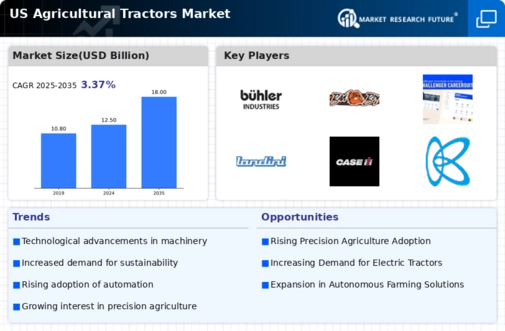Rising Labor Costs
Labor costs in the agricultural sector are on the rise, prompting farmers to seek more efficient solutions. The agricultural tractors market is likely to benefit from this trend as farmers turn to mechanization to mitigate labor expenses. With labor costs increasing by approximately 5% annually, the financial burden on farmers intensifies. Consequently, investing in tractors becomes a viable option to maintain profitability. The shift towards mechanization is expected to continue, as farmers look for ways to optimize their operations and reduce reliance on manual labor, thereby driving growth in the agricultural tractors market.
Government Support and Subsidies
Government initiatives play a crucial role in shaping the agricultural tractors market. Various federal and state programs provide financial assistance and subsidies to farmers for purchasing modern agricultural equipment. For instance, the USDA offers grants and low-interest loans to support the acquisition of tractors and other machinery. This financial backing encourages farmers to upgrade their equipment, thereby stimulating market growth. In 2024, it was estimated that government subsidies accounted for nearly 15% of total tractor sales in the US, highlighting the importance of such support in driving the agricultural tractors market.
Rising Demand for Food Production
The agricultural tractors market experiences a notable surge in demand driven by the increasing need for food production. As the US population continues to grow, the pressure on agricultural output intensifies. The USDA projects that by 2030, food production must increase by approximately 30% to meet the needs of the expanding population. This demand compels farmers to adopt advanced machinery, including tractors, to enhance efficiency and productivity. Consequently, the agricultural tractors market is likely to witness significant growth as farmers invest in modern equipment to optimize their operations and ensure food security.
Technological Innovations in Tractors
Technological advancements in tractor design and functionality are reshaping the agricultural tractors market. Innovations such as GPS-guided systems, precision farming tools, and automated features enhance operational efficiency and reduce resource wastage. The integration of smart technologies allows farmers to monitor and manage their equipment more effectively, leading to improved productivity. In 2025, it is projected that tractors equipped with advanced technology will account for over 40% of total sales in the agricultural tractors market. This trend indicates a shift towards more sophisticated machinery, reflecting the industry's response to evolving agricultural practices.
Increased Mechanization in Agriculture
The trend towards mechanization in agriculture significantly influences the market for agricultural tractors. Farmers are increasingly recognizing the benefits of using tractors to enhance productivity and reduce labor costs. The USDA reports that mechanization has led to a 20% increase in crop yields over the past decade. As labor shortages become more prevalent, the reliance on tractors and other machinery is expected to grow. This shift towards mechanization not only improves efficiency but also encourages the adoption of advanced technologies, further propelling the agricultural tractors market.


















Leave a Comment